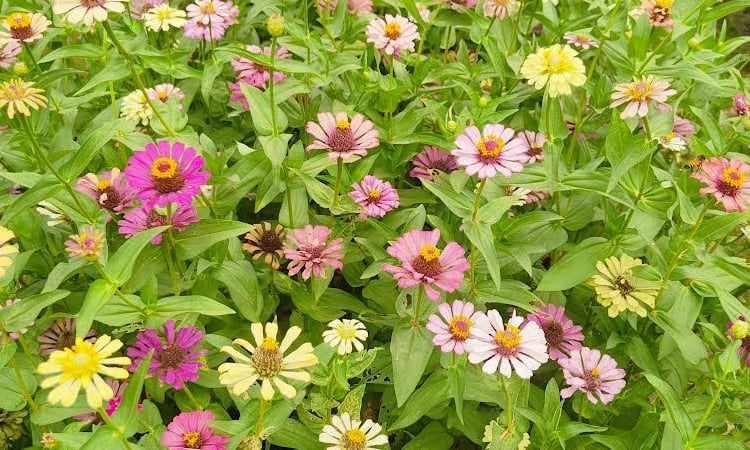News Flash
News Flash

By Mahamudur Rahman Najid
DHAKA, May 24, 2025 (BSS) - In a world where concrete rises and colors often fade into the gray, the zinnia flowers stand tall-vivid, resilient, and joyfully unapologetic in Ramna Park.
With its dazzling array of colors and shapes, this humble flower has quietly transformed gardens, balconies, and fields into vibrant canvases of life.
If the Amazon is the lungs of the world, then Ramna Park is undoubtedly the lungs of Dhaka. Ramna's green oasis is like a breath of peace amidst the hustle and bustle, smoke and concrete garbage of the capital.
This park with a century-old history is not just an entertainment center, but a vibrant green sanctuary.
Rare and exotic trees-Baobab, Bhadra, Ashoka, Kursi or escalator-give shade here. Nature lovers can get lost in the shade of these trees while wandering around Ramna.
However, to enjoy the beauty of the colorful zinnia flowers, one has to step into Ramna's own nursery. There, nature takes a step closer to its own in color, smell and creation.
A vibrant festival of colors is now in full bloom at Ramna's nursery and amidst this chromatic celebration, the flower that most captivates the eye is, without question, the zinnia.
From deep magenta and soft lavender to pure white and sunny yellow-clustered at the heart of the nursery, zinnias bloom like little bursts of joy, soothing the eyes and instilling a quiet serenity in the soul.
The true charm of zinnias lies in their kaleidoscope of colors.
Whether crimson red, fiery orange, royal purple, lemon yellow, or snowy white, each hue holds a unique allure. But these blooms are not admired for their beauty alone.
Their exceptional longevity makes them a favorite for floral arrangements. Whether in elegant vases or hand-tied bouquets, zinnias add a fresh, vivid touch that lasts.
From wedding altars draped in petals to the curated tablescapes of upscale events, and even as heartfelt gifts of affection-zinnias bring an unmistakable sense of elegance and emotion wherever they appear.
But their magic isn't reserved for human admirers alone. These radiant flowers also entice nature's delicate pollinators-bees, butterflies, and other winged visitors-making them vital contributors to the ecosystem's rhythm and renewal.
Native to the sun-drenched soils of Mexico, the zinnia carries a rich botanical heritage. Its scientific name, Zinnia elegans, honors the German botanist Johann Godfried Zinn, and it belongs to the diverse and vibrant Asteraceae family.
In essence, the zinnia is not just a flower-it's a radiant fusion of color, life and nature's quiet poetry.
The journey of the zinnia flower began with only a handful of species.
However, through years of dedicated research and successful cross-breeding by botanists, zinnias have evolved into a stunning array of colors, shapes, and sizes.
Originating in the warm soils of Mexico, this vibrant bloom has now made its way across the globe, becoming a beloved symbol of beauty and ornamentation.
To date, at least 20 distinct species of zinnia have been identified. Though it is primarily known as a winter flower, zinnia can be cultivated year-round, earning it a place in both decorative gardens and commercial farming landscapes.
Seed propagation is the primary method of growing zinnias. The ideal time for sowing seeds and transplanting seedlings typically spans from mid-June to October, offering optimal conditions for healthy growth.
According to Professor Dr. Shahriar Ahmed, Chairman of the Department of Botany at Jagannath University-"Bangladesh's soil and climate are highly suitable for zinnia cultivation. The national flower market is now valued at over a thousand crore taka, and zinnias are playing a significant role in that growth."
Zinnias enjoy heightened demand during a wide range of festivals and cultural celebrations, including spring festivals, Pahela Baishakh, Valentine's Day, religious pujas, and weddings.
Fueled by this steady demand, zinnia cultivation has emerged as a profitable agricultural venture. Many farmers are now cultivating zinnias commercially and achieving financial self-sufficiency in the process.
This growing industry is not only contributing to the rural economy but also creating employment opportunities-especially for women in agriculture.
Currently, zinnia cultivation is underway in at least 20 districts across Bangladesh, significantly expanding the scope and potential of the country's flourishing floriculture sector.
Dr. Shahriar Ahmed further noted, "One of the most significant aspects of the zinnia flower is its environmental contribution."
Beyond simply enhancing the aesthetic appeal of gardens and homes, zinnias attract pollinators like bees and butterflies, thereby playing an indirect yet valuable role in supporting agricultural ecosystems, he added.
He continued, "Zinnia is also an outstanding cut flower. Its long-lasting freshness and versatility make it a popular choice for a wide range of social, cultural, and ceremonial occasions.
In addition to its ornamental and ecological value, zinnia holds potential in the fields of research and education. Professor Shahriar remarked, "For students in agriculture and horticulture, zinnia cultivation offers a practical learning opportunity. Through hands-on experience, they gain insights into flower farming techniques, care practices, and crop management."
However, to unlock the full potential of this promising sector, access to high-quality seeds, training in modern cultivation techniques and robust support for marketing and distribution are essential.
He added: "Bangladesh's favorable climate and increasing demand for flowers have created a tremendous opportunity for zinnia cultivation. With appropriate support from both government and private sectors, zinnia can contribute significantly-not only to the national economy but also to the preservation of biodiversity."